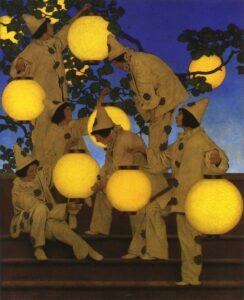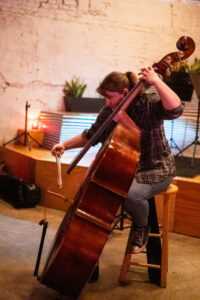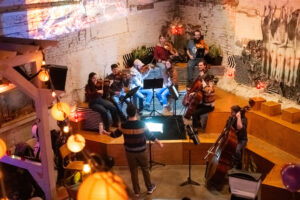From Nashville's Contemporary Music Scene:
‘Strings and Spirits’ at Bastion

After attending the Strings and Spirits concert on the evening of January 15th at Bastion in downtown Nashville, it became all the clearer to me what misfortune had occurred in arriving late to the venue that night (due to unforeseen circumstances, mind you). With no seats left to seize, I was forced to the back of the bar, drastically distanced from the performers, enough to obscure their faces as well as many aspects of their performance. Yet remarkably, an impact was still made – it was a concert of wonderfully pleasant character, diverse programming, and emotional investment.
While I had missed much of Britten’s Phantasy Quartet (1932), the evening’s conductor Daniel Krenz’s original work Parrish Blue was certainly not an unwelcome start to the evening. From one composer to another, I applaud not only the ensemble’s performance, but the composer’s grasp on maintaining interest and emotional continuity in this work, namely through his melodies – a true test of compositional prowess in my book. Dedicated to the composer’s wife, Krenz’s string quartet Parrish Blue strives to evoke qualities of artist Maxfield Parrish’s paintings and their bold colors. Only one movement of the quartet was performed, and while we were not enlightened as to which (if any) particular painting it was meant to emulate, it was nonetheless effective in communicating Krenz’s primary concern. Its melodies were sweet in quality, yet delightfully rich in harmonic depth, appearing most readily to me as an homage to the palette of Erich Wolfgang Korngold (particularly the love theme “Marian and Robin” from his score The Adventures of Robin Hood (1938)). While the work was certainly a fitting tribute wrought with compassion, it lacked the “bold” quality I came to expect from the description Krenz provided in his program notes. Perhaps listening to the remaining movements someday will provide greater context in this love-struck tableau.

I am quick to admit: I was not only taken aback by the third piece in the program, but was rather intrigued to see what a fusion of solo bass and the modern metal genre would entail in Rachael Smith’s Burn it Down (2022). While I was not entirely convinced the evening’s soloist was stark raving mad enough to communicate the concept the composer had so colorfully described in her notes for the piece, it nonetheless looked both fun to play and technically demanding enough to quell the anger of an aggravated double bassist. Although, it is worth mentioning how difficult it was to hear from the back of a humming venue which drowned much of the instrument’s lower frequencies. But from what could be discerned, intense snap pizzicato, tremolo glissandi runs, and some rhythmic grooves were no less enjoyable than a metal guitarist’s interpretation! It was an incredible change of pace to mark the midpoint of the concert and to treat the more thrill-seeking orchestral listeners in attendance (or for the metalheads, like myself)!
I had never heard of Josef Suk or his music prior to this concert, which was all the more surprising to me after reading of the acclaim he was given by his contemporaries. His Serenade for Strings (1892) facilitated his debut into my life that night, and it was no task to see how it is perhaps one of his most famous works. The piece was written as a response to a critique given by Dvořák of his melancholic style of writing, the result of which bore a work of impassioned and heart-warming content – the performers spared no expense in supporting this beautifully, to which they deserve all the kudos! The work having the attention of Brahms is perhaps not surprising. Complex yet uplifting harmonic movement and truly superb lyrical writing of was nearly enough to give the A-list Romantics a run for their money!

The most remarkable moment of the night happened during the piece’s third movement. It was only after the first few measures that an eerie and uncharacteristic silence befell the room, providing enough sonic real estate to let us soak in the deliciously rich and intimate work that was the Adagio. For me, this was incredibly reassuring; in a world where orchestral music finds itself further and further withdrawn from cultural popularity, the once bustling hole-in-the-hall, filled with all walks of life, fell into agreement that it deserved our attention. The third movement, with its gorgeous cello writing, certainly solidified the Serenade as my favorite selection of the night. But what can I say? I am a sucker for crafty orchestration and melodic content (it certainly helps the drinks lull you into a trance)! Unfortunately, with the entrance of the much livelier fourth movement, the energy found its way back into the crowd to overshadow much hope of hearing it in all its final glory. But who am I to complain? Perhaps that’s what good music should do sometimes!
Strings and Spirits proved itself to be a success, even from the perspective of a tardy, ill-positioned spectator – I truly hope to hear more from the performers and composers that contributed to such an evening! At the end of it all, I only envied the ones with a partner to enjoy it. With the venue’s lavish program, quality spirits, inviting decor, and faux fireplace projected onto the brick wall, it was quite the Romantic way to support the arts that cold, cold evening…




Thank you for the wonderful review, I am glad you were able to attend the concert. I hope to see you at some more of our future events!